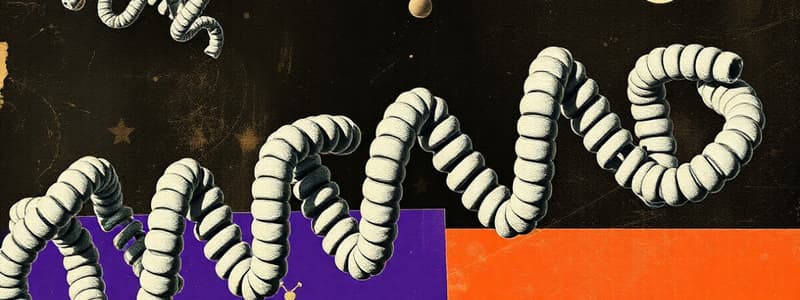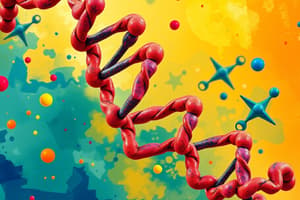Podcast
Questions and Answers
Which of the following is NOT a function of proteins?
Which of the following is NOT a function of proteins?
- Transport
- Catalysis
- Storage of genetic information (correct)
- Signalling
Amino acids consist of a central carbon atom, an amino group, and a carboxylic acid group.
Amino acids consist of a central carbon atom, an amino group, and a carboxylic acid group.
True (A)
Name one structural function of proteins.
Name one structural function of proteins.
Cytoskeleton, muscle, hair or nails.
Proteins are made up of ___________ linked together by peptide bonds.
Proteins are made up of ___________ linked together by peptide bonds.
What do enzymes primarily do?
What do enzymes primarily do?
Match the following protein functions with their correct descriptions:
Match the following protein functions with their correct descriptions:
There are fewer than 300 amino acids found in nature.
There are fewer than 300 amino acids found in nature.
What is the role of receptors in protein signaling?
What is the role of receptors in protein signaling?
How many amino acids are directly coded by DNA as proteinogenic amino acids?
How many amino acids are directly coded by DNA as proteinogenic amino acids?
All amino acids have a three-letter and one-letter abbreviation.
All amino acids have a three-letter and one-letter abbreviation.
What is the conformation of amino acids in protein structure?
What is the conformation of amino acids in protein structure?
The isoelectric point is the point where the net charge of an amino acid is ___ .
The isoelectric point is the point where the net charge of an amino acid is ___ .
Match the following amino acids with their characteristics:
Match the following amino acids with their characteristics:
Which of the following amino acids cannot be synthesized in mammals and must be obtained from the diet?
Which of the following amino acids cannot be synthesized in mammals and must be obtained from the diet?
Acidic amino acids contain an additional amino group compared to basic amino acids.
Acidic amino acids contain an additional amino group compared to basic amino acids.
In an acidic environment, what happens to the concentration of H+ ions?
In an acidic environment, what happens to the concentration of H+ ions?
What type of bond forms when two cysteine molecules come together?
What type of bond forms when two cysteine molecules come together?
Denaturation alters the primary structure of proteins.
Denaturation alters the primary structure of proteins.
What is released during the formation of a peptide bond?
What is released during the formation of a peptide bond?
The secondary structure of proteins is stabilized by ______ bonds.
The secondary structure of proteins is stabilized by ______ bonds.
Which of the following statements about tertiary structure is correct?
Which of the following statements about tertiary structure is correct?
What is the term for the process by which proteins regain their natural form after denaturation?
What is the term for the process by which proteins regain their natural form after denaturation?
Match the protein structure with its description:
Match the protein structure with its description:
Hydrophobic amino acids are typically found on the ______ of proteins in aqueous environments.
Hydrophobic amino acids are typically found on the ______ of proteins in aqueous environments.
Flashcards
Protein Functions
Protein Functions
Proteins have various roles in living organisms, including catalyzing reactions, transporting substances, signaling, and providing structural support.
Amino Acid Structure
Amino Acid Structure
Amino acids have a central carbon atom (alpha carbon) bonded to an amino group, a carboxyl group, and a variable side chain (radical group).
Protein Structure Levels
Protein Structure Levels
Proteins have four levels of hierarchical structure: primary, secondary, tertiary, and quaternary.
Protein Structure: Primary
Protein Structure: Primary
Signup and view all the flashcards
Protein Structure: Secondary
Protein Structure: Secondary
Signup and view all the flashcards
Protein Structure: Tertiary
Protein Structure: Tertiary
Signup and view all the flashcards
Protein Structure: Quaternary
Protein Structure: Quaternary
Signup and view all the flashcards
Protein Denaturation
Protein Denaturation
Signup and view all the flashcards
Proteinogenic amino acids
Proteinogenic amino acids
Signup and view all the flashcards
Selenocysteine
Selenocysteine
Signup and view all the flashcards
L-conformation
L-conformation
Signup and view all the flashcards
Amino acid abbreviations
Amino acid abbreviations
Signup and view all the flashcards
Amino acid mutations
Amino acid mutations
Signup and view all the flashcards
Essential amino acids
Essential amino acids
Signup and view all the flashcards
Amphoteric molecules
Amphoteric molecules
Signup and view all the flashcards
Isoelectric point
Isoelectric point
Signup and view all the flashcards
Peptide Bond Formation
Peptide Bond Formation
Signup and view all the flashcards
Secondary Structure (Proteins)
Secondary Structure (Proteins)
Signup and view all the flashcards
Tertiary Structure (Proteins)
Tertiary Structure (Proteins)
Signup and view all the flashcards
Disulfide Bonds
Disulfide Bonds
Signup and view all the flashcards
Quaternary Structure (Proteins)
Quaternary Structure (Proteins)
Signup and view all the flashcards
Denaturation
Denaturation
Signup and view all the flashcards
Denaturing agents
Denaturing agents
Signup and view all the flashcards
Renaturation
Renaturation
Signup and view all the flashcards
Study Notes
Amino Acids and Protein Structure
- Proteins are biomacromolecules composed of amino acids, performing various crucial bodily functions.
- Learning objectives include listing protein functions, describing amino acid structure, calculating isoelectric points, recognizing protein structures (primary, secondary, tertiary, and quaternary), and explaining protein denaturation.
- Proteins catalyze metabolic reactions by decreasing activation energy, transporting molecules, acting as hormones for directing metabolism, and giving structural support.
- DNA contains information for constructing proteins through transcription/translation pathways.
Protein Functions
- Proteins facilitate various essential tasks in living organisms, including:
- Catalysis (Enzymes): Increasing metabolic reaction rates by lowering activation energy.
- Transport: Moving molecules in the circulatory system or between cellular components.
- Signalling: Directing metabolism within the body via hormones and receptor interactions.
- Structural Elements: Providing structural support, like cytoskeleton, muscle, hair, and nails.
Protein Structure Summary
- Proteins have four levels of structure: primary, secondary, tertiary, and quaternary.
- The primary structure is the linear sequence of amino acid residues.
- Secondary structure involves local folding patterns like alpha-helices and beta-sheets due to hydrogen bonding.
- Tertiary structure forms the overall three-dimensional shape, resulting from interactions among amino acid side chains.
- Quaternary structure emerges when multiple polypeptide chains (subunits) assemble.
Amino Acids
- More than 300 amino acids exist in nature; however, only 20 are proteinogenic.
- 20 are directly coded by DNA; others can be incorporated.
- Amino acids have a central carbon atom (alpha-carbon), an amino group, a carboxyl group, and a variable side chain.
- Side chains vary in their chemical properties, influencing protein structure and function.
- Key amino acids include alanine, leucine, phenylalanine, tryptophan, isoleucine, valine, etc.
- Amino acids can be classified into four groups based on their side chain characteristics:
- Charged: Basic, acidic.
- Uncharged Polar: Serine, threonine, etc.
- Nonpolar: Alanine, valine, etc.
Amino Acids and pH
- Amino acids are amphoteric molecules, exhibiting both acidic and basic properties.
- pH affects amino acid structure and charge.
- Isoelectric point (pI): pH at which the net charge of an amino acid is zero.
Denaturation and Renaturation
- Denaturation disrupts the secondary, tertiary and quaternary structures of a protein by breaking hydrogen bonds and other interactions, but the primary remains.
- Renaturation allows a protein to regain its original structure under the required conditions.
- Factors that cause denaturation include altering pH, temperature, applying certain chemicals (organic solvents).
Essential Amino Acids
- Some amino acids cannot be synthesized by the human body and must be obtained through diet.
- These are considered essential amino acids.
- Examples of essential amino acids are valine, leucine, isoleucine, phenylalanine, threonine, tryptophan, methionine, histidine, and lysine. Other classifications and functions are also relevant within this subject.
Studying That Suits You
Use AI to generate personalized quizzes and flashcards to suit your learning preferences.




